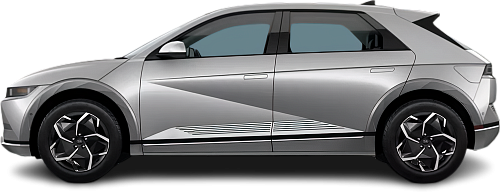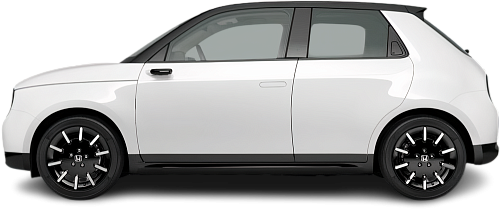USA EV Comparison: Hyundai Ioniq 5 Standard Range AWD vs Honda e Base
Struggling to Decide? Let AI Help!
Your AI Summary Is Ready!
General Info
Both vehicles have been discontinued and were never available for sale in the United States.
The Hyundai Ioniq 5 Standard Range AWD (2021-2022) is a SUV, whereas the Honda e (2020-2022) is a Hatchback.
| Property | Hyundai Ioniq 5 Standard Range AWD | Honda e Base |
|---|---|---|
| Years of Production | 2021-2022 | 2020-2022 |
| Current Status | Discontinued | Discontinued |
| Country of Manufacture | Indonesia, Singapore, South Korea | Japan |
| Body Style | SUV | Hatchback |
| Market Availability | EU | EU |
| GCC Score | 6.4 | 4.6 |
Range and Efficiency
While the Hyundai Ioniq 5 Standard Range AWD (2021-2022) offers a longer real-world range and a bigger battery, it is less energy-efficient than the Honda e (2020-2022).
| Property | Hyundai Ioniq 5 Standard Range AWD | Honda e Base |
|---|---|---|
| Range (WLTP) | 225 mi | 138 mi |
| Range (GCC) | 191 mi | 117 mi |
| Battery Capacity (Nominal) | 58 kWh | 35.5 kWh |
| Battery Capacity (Usable) | 54 kWh | 28.5 kWh |
| Efficiency per 100 mi | 28.3 kWh/100 mi | 24.4 kWh/100 mi |
| Efficiency per kWh | 3.54 mi/kWh | 4.11 mi/kWh |
| Range and Efficiency Score | 5.8 | 5.7 |
Charging
The Hyundai Ioniq 5 Standard Range AWD (2021-2022) features an advanced 800-volt architecture, whereas the Honda e (2020-2022) relies on a standard 400-volt system.
The Hyundai Ioniq 5 Standard Range AWD (2021-2022) offers faster charging speeds at DC stations, reaching up to 175 kW, while the Honda e (2020-2022) maxes out at 46 kW.
The Hyundai Ioniq 5 Standard Range AWD (2021-2022) features a more powerful on-board charger, supporting a maximum AC charging power of 10.9 kW, whereas the Honda e (2020-2022) is limited to 6.6 kW.
| Property | Hyundai Ioniq 5 Standard Range AWD | Honda e Base |
|---|---|---|
| Max Charging Power (AC) | 10.9 kW | 6.6 kW |
| Max Charging Power (DC) | 175 kW | 46 kW |
| Architecture | 800 V | 400 V |
| Charge Port | CCS Type 2 | CCS Type 2 |
| Charging Score | 6.9 | 3.5 |
Performance
The Honda e (2020-2022) is rear-wheel drive, while the Hyundai Ioniq 5 Standard Range AWD (2021-2022) offers an all-wheel drive system.
The Hyundai Ioniq 5 Standard Range AWD (2021-2022) boasts greater motor power and accelerates faster from 0 to 60 mph.
| Property | Hyundai Ioniq 5 Standard Range AWD | Honda e Base |
|---|---|---|
| Drive Type | AWD | RWD |
| Motor Type | PMSM (front), PMSM (rear) | PMSM |
| Motor Power (kW) | 173 kW | 100 kW |
| Motor Power (hp) | 232 hp | 134 hp |
| Motor Torque | 446 lb-ft | 232 lb-ft |
| 0-60 mph | 5.8 s | 8.7 s |
| Top Speed | 115 mph | 90 mph |
| Performance Score | 4.8 | 2.8 |
Dimensions
The Hyundai Ioniq 5 Standard Range AWD (2021-2022) is longer, wider, and taller.
The Hyundai Ioniq 5 Standard Range AWD (2021-2022) boasts a more extended wheelbase.
| Property | Hyundai Ioniq 5 Standard Range AWD | Honda e Base |
|---|---|---|
| Length | 182.5 in | 153.3 in |
| Width (with Mirrors) | 84.7 in | - Width (with Mirrors) |
| Width (w/o Mirrors) | 74.4 in | 69 in |
| Height | 63.2 in | 59.5 in |
| Wheelbase | 118.1 in | 99.9 in |
Cargo and Towing
The Hyundai Ioniq 5 Standard Range AWD (2021-2022) provides more cargo capacity, featuring both a larger trunk and more space with the rear seats folded.
A frunk (front trunk) is available in the Hyundai Ioniq 5 Standard Range AWD (2021-2022), but the Honda e (2020-2022) doesn’t have one.
Neither vehicle is officially rated for towing in the US.
| Property | Hyundai Ioniq 5 Standard Range AWD | Honda e Base |
|---|---|---|
| Number of Seats | 5 | 4 |
| Curb Weight | 4442 lb | 3501 lb |
| Cargo Volume (Trunk) | 26.3 ft3 | 6 ft3 |
| Cargo Volume (Max) | 58.5 ft3 | 30.4 ft3 |
| Cargo Volume (Frunk) | 0.8 ft3 | - Cargo Volume (Frunk) |
| Towing Capacity | - Towing Capacity | - Towing Capacity |
| Cargo and Towing Score | 6.6 | 3.8 |




